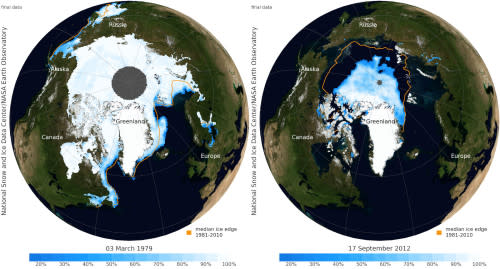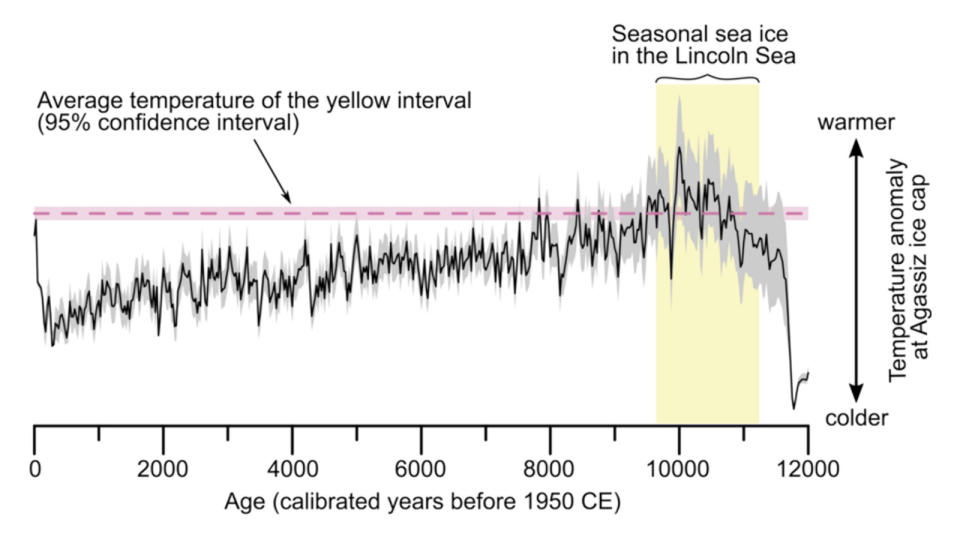Arctic's 'Last Ice Area' may soon disappear during summer months

New research reveals that the "Last Ice Area" north of Canada and Greenland has disappeared during the summer months in the past and it will do so again, perhaps sooner than we think.
Arctic sea ice goes through a seasonal cycle each year. It grows and spreads across the Arctic Ocean through northern fall and winter, even pushing into the North Atlantic and North Pacific by the time it reaches its maximum in February or March. Currently, nearly three-quarters of this sea ice is seasonal, meaning that it melts away through the spring and summer. The portion that survives the melt season is called year-round sea ice.

These two maps show the largest winter Arctic sea ice extent on record (left), from March 1979, and the smallest summer extent on record (right), from September 2012. (NSIDC)
Over the past four decades, records show that the amount of ice that survives year-round is dwindling. In the 1980s, the September sea ice minimums measured around 7 million square kilometres. The lowest minimum extent so far, in 2012, was less than half that. As global temperatures rise due to greenhouse gas emissions largely from burning fossil fuels, and the Arctic continues to be one of the fastest warming regions of the world, the amount of ice that survives the summer melt will continue to diminish.
Within the extent of the ice that survives each year's melt, though, is a region known as the Last Ice Area. It stretches from just north of Greenland through the northernmost islands of the Canadian Archipelago.

According to the World Wildlife Fund, as sea ice continues to dwindle due to global warming, this is the only region of the Arctic where we will have year-round sea ice as of 2040. Although the oceans could warm enough to melt this ice as well, due to the shelter provided by the islands and Greenland, it's thought that it could hold out decades longer than the rest of the sea ice. This would provide a crucial last bastion for Arctic wildlife and organisms that depend on the ice to survive.
However, according to a new study, even this Last Ice Area has melted away in the past, and as global temperatures continue to rise, we are quickly approaching a tipping point where we could see it disappear again.
Researchers from Denmark, Sweden, and the United States drilled down into the sea floor north of Greenland, in the Lincoln Sea, and pulled out samples that revealed how sediments were deposited in the area over time. Going through the samples layer by layer, they looked for specific chemicals produced by algae that cling to the underside of sea ice, and were able to construct a timeline showing when the algae were present, and thus when there was ice in that region.
"Climate models have suggested that summer sea ice in this region will melt in the coming decades, but it's uncertain if it will happen in 20, 30, 40 years, or more. This project has demonstrated that we're very close to this scenario, and that temperatures only have to increase a little before the ice will melt," Christof Pearce, one of the co-authors of the new study from Denmark's Aarhus University, said in a statement.
Their timeline revealed that around 10,000 years ago, there was a more than 1,000-year-long period when sea ice completely disappeared from the Arctic, even from the Last Ice Area, during the summer months.

This timeline of temperatures for the Agassiz ice cap, located on Ellesmere Island in the Canadian Archipelago, shows the peak of warming back in the Holocene period, 10,000 years ago (right), with the gradual cooling experienced up until the beginning of the Industrial Revolution and the current era, when temperatures have been rapidly rising again due to human activities (left). (Lecavalier et al. 2017/Detlef et al. 2023/Aarhus University)
As shown in the timeline above, temperatures in the Arctic now (at the left end of the graph) are quickly approaching what they were when the ice of the Last Ice Area became seasonal back in the early Holocene, roughly 10,000 years ago.
According to the study, this transition to seasonal Arctic sea ice in the Lincoln Sea and Last Ice Area will likely occur when global warming reaches 2°C above pre-industrial temperatures. The World Meteorological Agency says that, as of 2020, the globe is already 1.2°C warmer than it was in the late 19th century.
If the ice were to completely melt in the summer again, the devastating loss of habitat would be only the first problem. The increased area of dark water surface (as opposed to bright reflective ice surface) would mean even more heat being trapped in the ocean and an acceleration of the climate crisis.
"The bad news is that we can see this happening very soon," study co-author Henrieka Detlef, also from Aarhus University, said. "The good news is that our data shows the trend is reversible and we can do something about it if we reduce greenhouse gas emissions and set ambitious political goals. If we can keep temperatures stable or perhaps even make them fall, the sea ice would return to the area."
"The study is a wake-up call, because we know that it will happen," Pearce added. "This news is not making the situation more depressing, just more urgent. We have to act now so we can change it."
(Thumbnail image courtesy Tony Skerl/Pexels)


